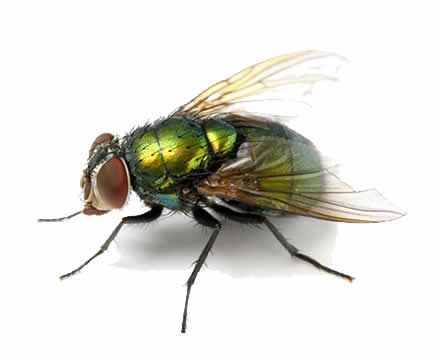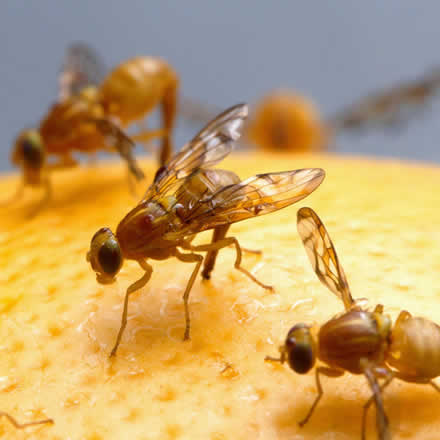Why are flies considered as pests?
Flies are a common sight in Australia. They are always considered as a nuisance to humans. It does not matter if you are in a coffee shop or in a restaurant, you are very likely to meet one or more fly species. Find out more about one of the most common pests in Sydney.
If you have any questions, you may consult our team by sending us a message or calling (02) 8007 4666.
Tell us your problem
FREE QUOTE
Biology
All flies belong to the Diptera order, which consists of 150,00 species. Among those, 6,000 species can be found in Australia. They inhabit all parts of Australia, but most of them can be found in forests and near fresh water sources.
Despite some differences in their structure, the majority of adult flies can be recognised easily by having only one pair of wings that are functional. The hind wings are known as “halteres,” which vibrate during flight. They are actually a gyroscopic organ that gives them balance. The head carries a pair of large eyes and an antennae. Their mouthparts are made for sucking and mopping up nectar. Some species such as mosquitoes have mouthparts that have evolved into biting tools that can pierce skin and suck blood.
The Life Cycle of a Fly
During their lifecycle, flies go through a complete metamorphosis. Most adult females are oviparous and lay eggs near or on food sources. Some flies such as those that belong to the family Sarcophagidae are known as flesh flies. They are viviparous which means that they deposit live larvae on decomposing matter. The emerging larvae feed on decomposing vegetable matter and some are even predatory or parasitic. After they are fully fed, the pupate emerge as adults.
Removing flies can be tricky as they reproduce quickly. Get FREE advice from our pest experts! Call us on (02) 8007 4666 today!


Pest Guide - Fly Infestation in Australia
Common Fly Species
These are the common fly species that we come in contact with in Australia:
Muscidae family
Known as a common house fly, it can grow from 5 to 8 mm. It is characterised by having a grey thorax abdomen. This is the best known species is the Musca domestica. Adult flies are known to carry a broad range of pathogenic bacteria that can affect both humans and domestic animals. Their larvae can be found in animal faeces and decomposing matter.
A lesser house fly (Fannia canicularis) is also a very common and known species which can be distinguished by its erratic flight. Their size range from 3 mm to 6 mm long with grey thorax and abdomen. They have distinctive stripes on their thorax. Adults are found in domestic areas and animal houses. Their Larvae feed on organic matter.
A rather uncommon species is the stable fly (Stomoxys calcitrans). It is very rare to find these flies inside homes, but they are common in animal facilities. These flies are about 5 to 7 mm in size and have a very distinctive piercing and sucking mouthparts. They rest with their wings widely apart. The larvae feed on almost all organic material while adults feed on animal blood.
Bluebottles or blow flies (Family Calliphoridae)
Blow Flies is a large family with a stouter build than the Muscidae. They grow up to 13 mm in size and can come in a variety of colours which range from black, green, blue and bronze. Adult blow flies are strongly attracted to moisture and eat mainly nectar, honey and other sweet liquids. The larvae are known to cause “blow fly strike” in sheep. which is a condition that causes many millions of dollars in damage to the industry.
Fruit flies (Family Tephritidae)
These flies can be found everywhere there is fruit. These flies can be found primarily around decaying fruit. When indoors, these flies can be seen flying over fruits and veggies, garbage and bottles of fruit juices, beer, wine and vinegar. You can sometimes see hundreds of them in one food source. Fruit flies are significant pests that affect commercial industries and can cause significant damage if left untreated.
Adults eat sap, nectar, honey and droppings. Fruit flies can become a problem in homes and restaurants when there is a presence of rotting or decaying fruit. Adults can grow from 3 mm to 6 mm and have brown and yellow or brown and black eyes, while some can even have completely red eyes. Their head and thorax are tan while the abdomen is black.


Fruit Flies
Drain or Moth flies (family Psychodidae)
Moth flies can often be seen in bathrooms and toilets. Adult moth flies are common indoors around drains and urinals. They are the result of drain issues such as blocked and broken drains. When you have blocked drains, organic matter accumulates on which drain flies feed. Same as vinegar flies, drain flies are a result of low hygiene.
Adult moth flies are very small, typically between 4 mm to 5 mm with a dark coloured body covered in hair including their wings. Their wings can seem too large for their body. They are poor fliers and are known to have irregular flight.
Flesh flies (family Sarcophagidae)
Flesh flies can grow up to 13 mm. These flies have a striped thorax and a pattern on their abdomen. They can be found near carcasses such as dead rats. If you see them on the wall or ceiling, you can be certain that there is something dead in the vicinity.
Sciarid (family Sciaridae)
Sciarid is a common family of small flies. Their larvae can be found in great numbers on rotting vegetables or soils with high amounts of organic matter. Pest controllers can find them in houses with pot plants in which they are breeding.
Phorid (Hunchback) flies
Phorid flies, from the family Phoridae, have similar habits as sciarid flies. Adult phorid flies are very small with a large thorax. They can be found in houses with gardens and potted plants.
Biting flies
Biting flies include species such as horse flies, sand flies, stable and black flies.
Contact the masters!
Get a complete pest solution to protect your family from flies and other pests such as rats, termites, cockroaches and bed bugs. Call the masters on (02) 8007 4666 for pest management anywhere in Sydney.
Sign up to our mailing list to get the latest updates and pest control news from our experts. Join now and get a downloadable pest guide!
